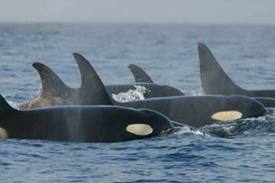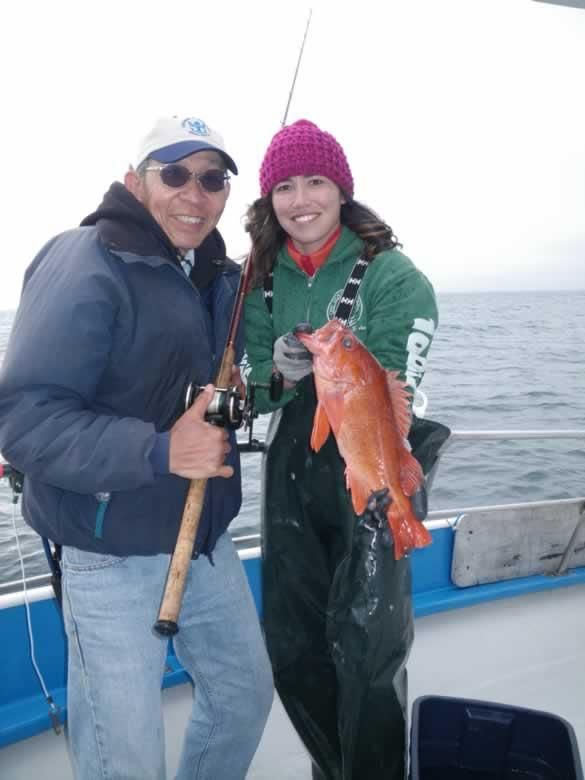 Protection for endangered orcas or "killer whales" off the Pacific Coast may be about to disappear. Lori Abbot reports.
Protection for endangered orcas or "killer whales" off the Pacific Coast may be about to disappear. Lori Abbot reports.
 Anaheim boasted a thriving wine industry in the late 1800s, before an unnamed affliction killed 40,000 acres of the grapevines and put 50 wineries out of business. The problem was later found to have been Pierce's disease of grapevines. Would Anaheim be wine country today if it weren't for Pierce's disease? Probably not, but the sad fate of this Southern California wine industry underscores the importance of controlling the disease and the insects that spread it in California's thriving grape growing regions.
Anaheim boasted a thriving wine industry in the late 1800s, before an unnamed affliction killed 40,000 acres of the grapevines and put 50 wineries out of business. The problem was later found to have been Pierce's disease of grapevines. Would Anaheim be wine country today if it weren't for Pierce's disease? Probably not, but the sad fate of this Southern California wine industry underscores the importance of controlling the disease and the insects that spread it in California's thriving grape growing regions.
The bacterium that causes Pierce's disease has always existed in California, affecting a wide variety of plants, from oleanders to almonds. But the problem shot to prominence in the 1990s with the inadvertent introduction into California of the glassy-winged sharpshooter. The insect is native to the southeastern United States and was most likely brought into California accidentally as egg masses in ornamental or agricultural plant foliage.
GWSS has turned out to be a very efficient vector of Xyella fastidiosa, the bacterium that causes Pierce's disease in grapes. When GWSS made their way to places where scientists believed the bacterium didn't exist, such as Kern County, grapevines began to express symptoms of the disease. The county agricultural commissioners in the San Joaquin Valley have been working tirelessly over the last 10 years to keep glassy-winged sharpshooters out of grape growing regions to protect a very valuable economic driver. In Fresno County alone, where grapes are the No. 1 agricultural commodity, the crop was worth $961 million in 2011.
Despite the efforts to contain GWSS in Fresno County, the pest is spreading very gradually south and east of the Fresno-Clovis metropolitan area into commercial vineyards and orchards.
"Cooperation by urban residents where we find GWSS has been great," said Fred Rinder of the Fresno County Agricultural Commissioner's office. Nevertheless, in 2012, GWSS was found spreading out in Kerman, Parlier, Sanger and Kingsburg.
Stephen Vasquez, UC Cooperative Extension advisor in Fresno County, fears local grape farmers have become complacent about glassy-winged sharpshooter and Pierce's disease, even though all grapes are susceptible. The best way to control its spread, he said, is to monitor and manage sharpshooter vectors and remove and replace vines that have tested positive for Xylella fastidiosa.
"Be vigilant. Learn the symptoms and train crews and workers," Vasquez said. "Pierce's disease has been around for a long time and GWSS has been here more than a decade, but we still haven't had that marriage of the two. That is potentially devastating."
What People Are Saying about Rebels With a Cause
REBELS WITH A CAUSE is really moving out into the world – thanks in large part to your help. Please take a minute to bask in the warm light of these comments from four screenings that took place over this past weekend. And take a look at the schedule of upcoming screenings – hope you can save a date to come see REBELS.
I was so immersed in your wonderful film, I almost forgot my name. I want to talk to the County about having a showing here at the Civic Center. I think it is so important to let people who weren’t here then, but who are involved now, to know the history of why Marin is who it is: the lungs of the Bay Area.
We all loved your film! Fantastic!
It's very moving. And it's so uplifting to see how a bunch of local folks at kitchen tables saved so much land from development. And, it's very heartening to see a bi-partisan effort work—back in the day when conservatives were interested in conserving.
A great event to support some fantastic storytellers and friends. It was fun to partner with Point Reyes Books on an event…thank you Steve and Kate! One guest last night said he’d lived through and been involved with different aspects of the founding of the parks and finally felt he understood the whole story. I couldn’t agree more. Congratulations!
Point Reyes National Seashore Association
I just want to let you know how great it was to watch the film in Nevada City and be there to help cheer you on. You've really done a terrific job and I'm hoping this gets all the coverage and support it and you deserve. I heard from Amy Meyer and Michael Rosenthal that the showings in Pt. Reyes Station yesterday were a smash hit. I went to your Nevada City showing with an old friend and colleague who knows quite a bit about conservation and the Bay Area...but she learned a lot she hadn't known...a reminder to me (as if I needed one) about how important it is to tell these stories and pass them on from one generation to the next. They get lost too easily in the fog of time.
I attended the film Rebels with a Cause, on Sunday, for the 6 p.m. show. What a glorious achievement this film is. A completely engaging and inspiring tale, supported with phenomenal historical research and boasting a real-life cast of characters and personalities that would be any director’s dream. The quality of the film matches the greatness of the conservation efforts it retells. Have not seen any of Nancy and Kenji’s other films, but now I’d like to see them all. Center for Biological Diversity
I hope the screening went well, and have had two delighted reviews from attendees that I know.
It felt to me like a real honor to stand up there with you and Kenji and to be associated in that way with your wonderful film. I have huge respect for both of you and all the time, talent and dedication you put in to Rebels. I know that the film will go on being shown and appreciated for many, many years ahead. The Trust for Public Land
 Styrofoam — referring generically to #6 expanded polystyrene foam — is a disposal headache. Extremely bulky, yet lightweight, it takes up space in the waste stream (and in landfills), but its removal doesn't add much value to what is known as "diversion numbers."
Styrofoam — referring generically to #6 expanded polystyrene foam — is a disposal headache. Extremely bulky, yet lightweight, it takes up space in the waste stream (and in landfills), but its removal doesn't add much value to what is known as "diversion numbers."
In 1989, California Assembly Bill 939, known as the Integrated Waste Management Act, mandated reduction (or diversion) in waste disposal: jurisdictions were required to meet a 50 percent diversion goal by the year 2000. In 2011, Governor Jerry Brown signed AB 341, requiring a 75 percent reduction in disposable waste by 2020.
These goals are based on weight. So, for example, "green wastes" (lawn and garden clippings with a high water content) are targeted for removal from the waste collection system. Lightweight Styrofoam is ignored because its removal doesn't add much to diversion goals.
Many holiday gifts, such as electronics and wine, come packed in #6 Styrofoam. That's why UC Cooperative Extension Master Gardeners in Tuolumne County host semi-annual Styrofoam awareness events to collect foam from the public. Last On  Baled styrofoamSaturday and Sunday, Jan. 12 and 13, the Master Gardeners unloaded vehicles and collected Styrofoam from holiday gifts. Once collected, that foam will be compacted, baled and transported for recycling.
Baled styrofoamSaturday and Sunday, Jan. 12 and 13, the Master Gardeners unloaded vehicles and collected Styrofoam from holiday gifts. Once collected, that foam will be compacted, baled and transported for recycling.
Started in honor of Earth Day 2007, the Master Gardener Save Our Styrofoam (SOS) project has received collaborative support from local waste haulers and county government agencies. Waste Management Inc. (WMI) donates 20-foot roll-off bins to hold the collected Styrofoam. WMI then compacts and bales the foam. Tuolumne County's Solid Waste Division arranges with the county's e-waste hauler to pick up and deliver the Styrofoam bales. A Lodi, Calif., division of Dart Container Corporation repurposes the recycled Styrofoam into food containers.
Styrofoam collection events have been held at the California State Fair and by various other recycling groups. The hope is that, eventually, with California's focus on recycling, Styrofoam will no longer be a product created from fossil fuels that is then eliminated by being buried in the earth.
 In California, the adage goes, "Whiskey's for drinking and water's for fighting." Often that goes for the coastal oceans, as well as inland waterways. But not always. Lori Abbot reports on a current cooperative effort.
In California, the adage goes, "Whiskey's for drinking and water's for fighting." Often that goes for the coastal oceans, as well as inland waterways. But not always. Lori Abbot reports on a current cooperative effort.
At right: Volunteer recreational angler Ken Yuen and CCFRP scientist Jahnava Duryea collecting data on nearshore fishes at Half Moon Bay. Credit: California Collaborative Fisheries Research Program.

 Live Radio
Live Radio